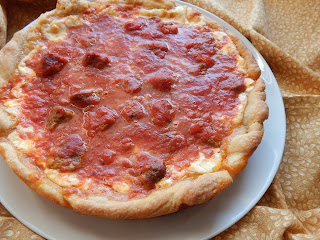A lot of people don't consider deep dish 'real' pizza. For me, I think it's pizza but in a whole different category. It's obviously not your typical thin and crispy or soft and puffy yeasty dough; it's a thick, buttery, flaky crust with a touch of cornmeal for some extra crunch. That gets layered with mozzarella cheese and then the sauce so that the sauce doesn't make the crust all soggy while it bakes. I recommend adding some toppings (my favorite is meatballs) on the cheese before the sauce so they don't dry out; the toppings break up the insane amounts of crust, cheese, and sauce so there's actually some substance (and maybe some healthy stuff) there.
If you've ever made pizza dough (or any yeasted bread before) you'll recognize a lot of the basic techniques. You have to activate the yeast in some warm water and a bit of sugar, then mix it with the dry ingredients and knead until elastic. This is pretty similar except you'll add some cornmeal for texture and some melted butter for richness. The dough has to rise for a bit and then the fun part begins. You get to slather the whole slab of dough in butter, roll it up, and let it rise again. It's kind of like making cinnamon rolls except it's just butter and you get a pizza at the end.
The sauce may also be a little bit different than what you're accustomed to. Deep dish pizzas usually have a raw, chunky tomato sauce that gets cooked while the pizza bakes for a long time (it's not one of those 90 second Neapolitan pizzas). I like to use a can of crushed San Marzano tomatoes since they have some texture without being too chunky for my taste and they have such a bright flavor with just the right amount of sweetness and acidity. Of course, just about any can of any tomatoes will work; you can take canned whole tomatoes and crush them yourself or just go with a can of tomato puree for a smooth sauce. I combine the tomatoes with some garlic, onions, spices, and a bit more sugar and lemon juice to taste. I only let it cook for a few minutes until all the flavors meld together since it will get cooked for a long time while on the pizza.
Real Chicago deep dish places often have their own special pans for baking the pizzas so they cook through and get all nice and crispy without over-browning. I've found that a regular 9" round metal cake pan yields a crispy crust and can hold all the deep dish action without overflowing. Just press in the dough and make sure it creeps all the way up the sides. I top it with thin slices of mozzarella (slices are better than shredded here, trust me), all my toppings (gotta have those meatballs), and a few ladles of sauce to cover everything. As tasty and decadent as all of this is, the best part is that it makes two whole pizzas, and they make great leftovers.
3 1/2 Cups Flour
1/2 Cup Yellow Cornmeal
1 1/4 tsp Salt
1 T Sugar
2 1/4 tsp Yeast
1 1/4 Cups Warm Water
1/2 Stick Butter, Softened
1/2 Stick Butter, Melted
1 28oz Can Crushed Tomatoes
1 Small Onion, Diced/Minced
3 Cloves Garlic, Minced
2 T Sugar
1 tsp Lemon Juice
1/4 tsp Basil
1/4 tsp Oregano
1/4 tsp Thyme
12oz Mozzarella, Sliced
1/3 Cup Grated Parmesan
Meats and Vegetables
In the bowl of a stand mixer, combine the warm water, yeast, and sugar. Let sit for 5-10 minutes or until the yeast has activated. Using the dough hook, stir in 2 cups of flour, cornmeal, and salt. Add the melted butter, then gradually add the remaining flour until the dough comes together. Knead on medium-low speed for 5 minutes or until it is elastic and pulls away from the bowl, adding more flour as necessary.
Roll the dough into a ball and place in a large greased bowl. Cover with plastic wrap and let rise in a warm area for 1-2 hours or until doubled in volume.
Punch the dough down and turn onto a floured surface. Roll into a rectangle about 1/2" thick and spread evenly with the softened butter. Roll into a log and cut in half. Place the dough balls back into greased bowls, cover, and let rise again for an hour in a warm area.
Meanwhile, heat some oil in a medium pot. Add the onion and cook for 2 minutes or until fragrant and translucent. Add the garlic and cook for 1 minute. Stir in the tomatoes, sugar, lemon juice, basil, oregano, and thyme. Simmer for 20 minutes.
Heat oven to 425F and grease 2 9" cake pans.
Roll each ball of dough out to fit the pans, making sure the crust goes all the way up the sides. Place the mozzarella slices on the crust, limiting gaps as much as possible. Top with any meats or vegetables, then spread the sauce on to cover. Sprinkle with the parmesan.
Bake for 25-30 minutes or until the crust is deeply browned.
Makes 2 9" Pizzas
Recipe Adapted from Sally's Baking Addiction



















